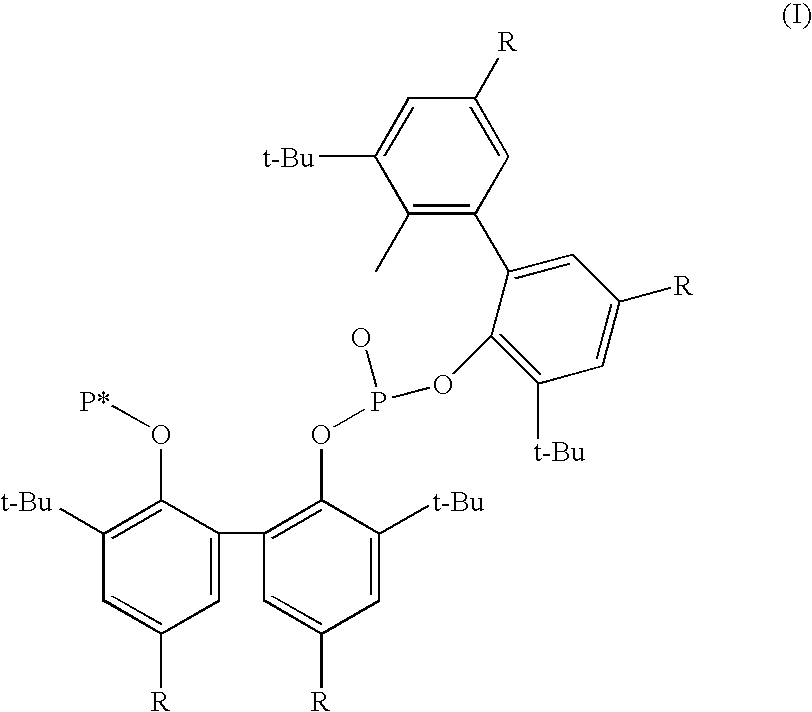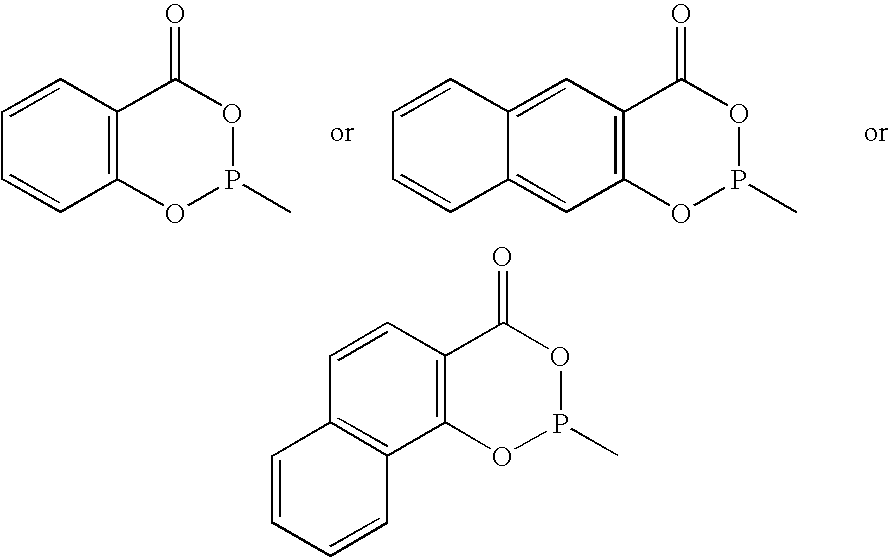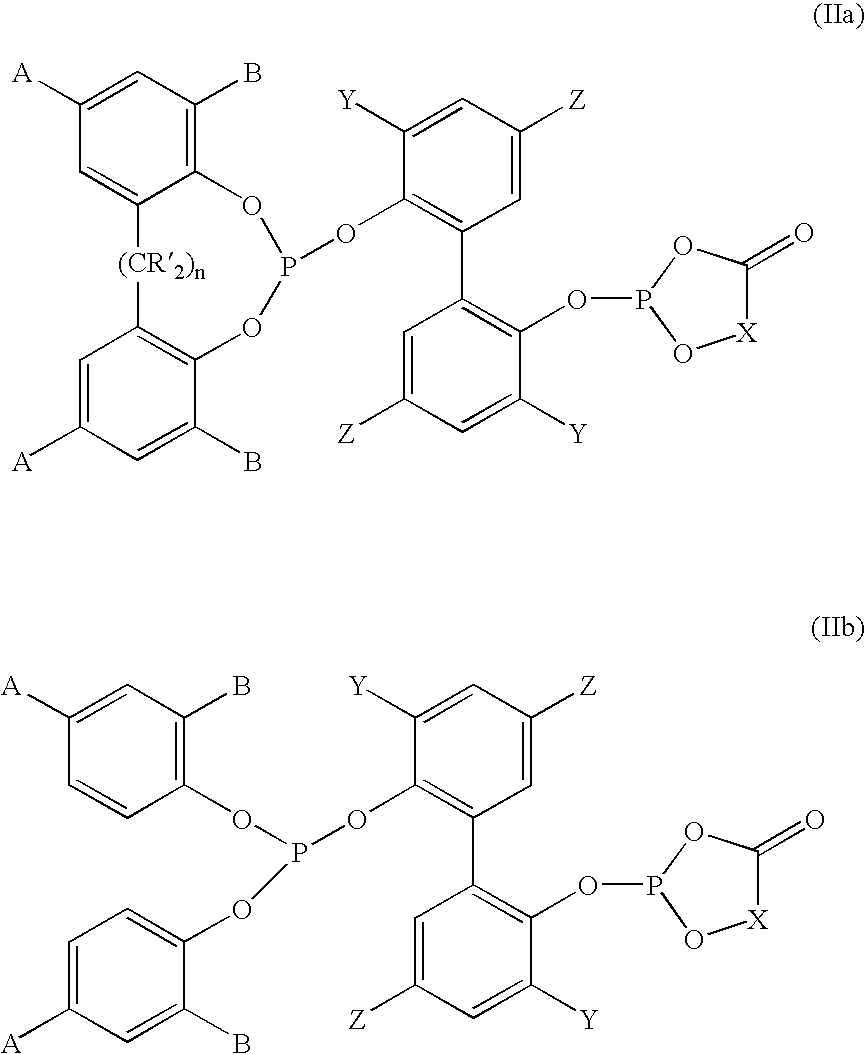Phosoxophite ligands and use thereof in carbonylation processes
a phosoxophite ligand and carbonylation technology, applied in the field of new organophosphorus composition, can solve the problems of only moderate or low activity of phosphorus ligand complexes, and the ligands disclosed in the art cannot be easily fine-tuned to provide a high selectivity, so as to improve the ease of fine-tuning selectivity, the effect of increasing activity
- Summary
- Abstract
- Description
- Claims
- Application Information
AI Technical Summary
Benefits of technology
Problems solved by technology
Method used
Image
Examples
example 1
Preparation of Phosphoromonochloridite
[0060]3,3′-Di-t-butyl-5,5′-di-t-pivaloyloxy-2,2′-biphenylphosphoromonochloridite (PIV-PCl) of the following formula
[0061]
was prepared as follows. To a 250 ml round bottom flask were added 3,3′-di-t-butyl-5,5′-di-t-pivaloyloxy-2,2′-biphenol (PIV-diol) (7.63 g, 15.3 mmol), diethyl ether (80 ml), tetrahydrofuran (40 ml), and N,N-dimethylaniline (DMA, 3.90 g, 32.2 mmol). Phosphorus trichloride (2.20 g, 16.0 mmol) was placed in a separate flask and diluted with diethyl ether (10 ml). After cooling both solutions to −30° C., the ether solution containing the phosphorus trichloride was quickly added to the THF-ether solution containing the PIV-diol and DMA. After stirring for 1 h, during which time the solution was warmed to ambient temperature, a 31P NMR sample was taken. The NMR data, which was acquired immediately, showed the reaction to be complete. A solid product, including the hydrochloride salt of N,N-dimethylaniline, was filtered and washed wi...
example 2
Preparation of Phosoxophite Composition of Formula M
[0062]A dichloro-bisphosphite composition (PIV-TMS-PCl2) having the formula shown below was prepared as follows:
[0063]
To a cold (−30° C.) solution containing tetrahydrofuran (10 ml), triethylamine (0.537 g, 5.062 mmol), and phosphoromonochloridite PIV-PCl from Example 1 (3.00 g, 5.38 mmol) was added quickly a cold (−30° C.) solution-containing tetrahydrofuran (10 ml) and 3,3′-bis(trimethylsilyl)-5,5′-di-t-butyl-2,2′-biphenol (TMS-diol) (2.358 g, 5.325 mmol). After stirring the resulting reaction mixture for 30 min at ambient temperature, a triethylamine hydrochloride salt was removed by filtration. After cooling the filtrate to −30° C., PCl3 (1.08 g, 7.86 mmol) was added followed by triethylamine (0.75 g, 7.86 mmol). The reaction mixture was stirred for one hour at room temperature. Then, a second batch of triethylamine hydrochloride salt was removed by filtration. The filtrate was evaporated to dryness and the solid residue tritur...
example 3
Organophosoxosphite Ligands and Hydroformylation Process
[0065]Phosoxophite ligands N, O, Q, R, FF, and GG, shown in the most preferred example list hereinabove, were synthesized in a manner analogous to the preparation given for phosoxophite composition M in Example 2. The following specific reactants were used.
[0066]Phosoxophite N was prepared by reacting PIV-TMS-PCl2, prepared in Example 2, with 3,5-diisopropylsalicylic acid. Purified yield: 80%. Four diastereomers were observed in 31P {1H} NMR spectrum in the ratio close to 56:26:15:3. 31P {1H} NMR (121.66 MHz, CDCl3, δ): diastereomer 1 (56%): 120.84 and 140.26 ppm(s); diastereomer 2 (26%): 117.48 and 141.05 ppm (d, JP-P=9.5 Hz); diastereomer 3 (15%): 121.30 and 143.11 ppm(s); diastereomer 4 (3%): 117.35 and 140.82 ppm(s).
[0067]Phosoxophite O was prepared by reacting PIV-TMS-PCl2, prepared in Example 2, with 2-ethyl-2-hydroxybutyric acid. Purified yield: 95%. Four diastereomers were observed in 31P {1H} NMR spectrum in the ratio ...
PUM
| Property | Measurement | Unit |
|---|---|---|
| temperature | aaaaa | aaaaa |
| temperature | aaaaa | aaaaa |
| temperature | aaaaa | aaaaa |
Abstract
Description
Claims
Application Information
 Login to View More
Login to View More - R&D
- Intellectual Property
- Life Sciences
- Materials
- Tech Scout
- Unparalleled Data Quality
- Higher Quality Content
- 60% Fewer Hallucinations
Browse by: Latest US Patents, China's latest patents, Technical Efficacy Thesaurus, Application Domain, Technology Topic, Popular Technical Reports.
© 2025 PatSnap. All rights reserved.Legal|Privacy policy|Modern Slavery Act Transparency Statement|Sitemap|About US| Contact US: help@patsnap.com



